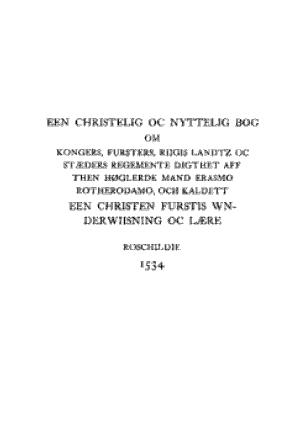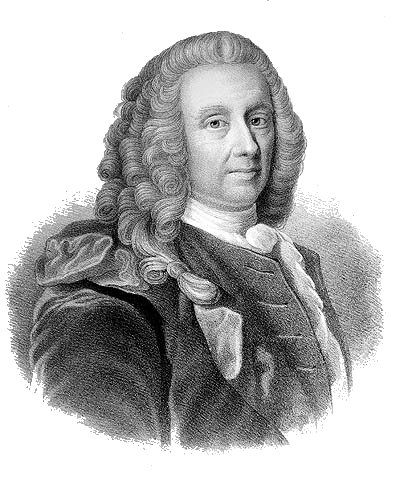Holger Terp: Danish Peace History
Working paper 1
Danish Peace Literature
 The first Latin
printed book in Denmark was on war22. The possible first
pacific book in Denmark was printed shortly after the reformation:
Erasmus of Rotterdam's “Een christelig og nyttig bog om
kongers, fursters riigts landes oc stoeders regimente digtighed ...
och kaldet en christen fyrstis underwiisning och laere”,
printed according to Jacob ter Meulen in Roskilde 1534; a
translation of “Institutio principes christiani
saluber-rimis referta præceptis”, or The
Education of a Christian Prince, from 1515. The volume of
Erasmus of Rotterdam is the first Danish entry in Jacob ter
Meulen's Bibliography of the peace movement before 1899,
1480-1776. There are two copies of Een christelig og nyttig
bog om kongers, fursters riigts landes oc stoeders regimente
digtighed in the Royal Library in Copenhagen. The translater
was the karmaliter monk, author and historian Poul Helgesen or
Paulus Helie (1485-1534). Sebastian Olden Jørgensen wrote in
the Royal Library's Arkiv for Dansk Litteratur - “Poul
Helgesen - Forfatterportræt”, that, “the
translation in 1522 of Erasmus af Rotterdam's prince mirror
(fyrstespejl) were an attempt to shout to King Christian II and
warn him against the tyrrany, he were about to induce.”
(Oversættelsen af Erasmus af Rotterdams fyrstespejl En
cristhen førstis lære ( SPH I 3-159) fra 1522 var et
forsøg på at råbe Christian II op og advare ham
mod det tyranni, han var ved at bevæge sig ud i). Een
christelig og nyttig bog om kongers, fursters riigts landes oc
stoeders regimente digtighed is republished in Skrifter af
Paulus Helie vol. 5 (pp: I - 333). Arkiv for Dansk Litteratur
has published Een christelig og nyttig bog om kongers, fursters
riigts landes oc stoeders regimente digtighed on the Internet.
There are a second early printing of The Education of a
Christian Prince printed in Aarhus.
The first Latin
printed book in Denmark was on war22. The possible first
pacific book in Denmark was printed shortly after the reformation:
Erasmus of Rotterdam's “Een christelig og nyttig bog om
kongers, fursters riigts landes oc stoeders regimente digtighed ...
och kaldet en christen fyrstis underwiisning och laere”,
printed according to Jacob ter Meulen in Roskilde 1534; a
translation of “Institutio principes christiani
saluber-rimis referta præceptis”, or The
Education of a Christian Prince, from 1515. The volume of
Erasmus of Rotterdam is the first Danish entry in Jacob ter
Meulen's Bibliography of the peace movement before 1899,
1480-1776. There are two copies of Een christelig og nyttig
bog om kongers, fursters riigts landes oc stoeders regimente
digtighed in the Royal Library in Copenhagen. The translater
was the karmaliter monk, author and historian Poul Helgesen or
Paulus Helie (1485-1534). Sebastian Olden Jørgensen wrote in
the Royal Library's Arkiv for Dansk Litteratur - “Poul
Helgesen - Forfatterportræt”, that, “the
translation in 1522 of Erasmus af Rotterdam's prince mirror
(fyrstespejl) were an attempt to shout to King Christian II and
warn him against the tyrrany, he were about to induce.”
(Oversættelsen af Erasmus af Rotterdams fyrstespejl En
cristhen førstis lære ( SPH I 3-159) fra 1522 var et
forsøg på at råbe Christian II op og advare ham
mod det tyranni, han var ved at bevæge sig ud i). Een
christelig og nyttig bog om kongers, fursters riigts landes oc
stoeders regimente digtighed is republished in Skrifter af
Paulus Helie vol. 5 (pp: I - 333). Arkiv for Dansk Litteratur
has published Een christelig og nyttig bog om kongers, fursters
riigts landes oc stoeders regimente digtighed on the Internet.
There are a second early printing of The Education of a
Christian Prince printed in Aarhus.
Also there is a early Danish publication of “The Praise of Folly”: Erasmus, Desiderius: Moria eller Daarligheds Berømmelse / overs. af [uoplyst, formentlig Barthold Johan Lodde] : med dedikation af Barthold Johan Lodde ; med forord af oversætteren ; med anmærkninger og forklaringer ; med et kobberstik af ??? - Altona : Studenterforeningen, 1745. 32 + 199 pp. This translation and publication is not in Bibliography of the peace movement before 1899, 1480-1776.
Around the same time as the sermon of Könecken a theological booklet was circulated: “A little track, how a just Christian soldier ought to warre against spiritual and carnal enemies. Also on some causes to War; thereupon, on the noble and precious gift of the peace of' God”. This edifying booklet was an reprint of an edition from 1647, where the name of the author appears: Jens Søffrensen Nørnissom23. According to Bibliotheca Danica, this is the only Danish published publication recorded in the national bibliography relevant here.
Foreign peace books were banned and burned in Scandinavia: Paul Felgenhauer's “Perspicillum Bellicum” was, according to Arthur Thuesen, published in Germany in 1652 and translated into and published in Swedish by peace apostle Anders Pedersson Kempe in 166424. The book was banned in both Sweden and Norway and on March 31, 1671 judged to be burned on the fire. It is not known, but likely, that this book also was banned in Denmark.

Jesper Baltzarsen Könecken explained to the court, that before he wrote “De bellis Christianorum Novi Testamenti”, he had read one German book with the title “Irenicum” by an unknown author. If I read Jacob ter Meulen right, the author could be Daniel Zwicker, whose “Irenicum irenicorum” first was published in Amsterdam in 1658, short time before Könecken’s sermon. The early Danish conception of peace and pacifism needs to be investigated.
Danish-Norwegian censure, established during the church reformation in 1536, was not complete25. Privileged could read Marsilius of Padna: “Defensor Pacis” / Defender of the Peace, the Bomb Book. Basle, 1522; which later was partly destroyed during the British terror bombardment of Copenhagen in 1807. In 1738 the printer or publisher T. Sowle Raylton in London published a Danish translation of Robert Barclay's “Apology for the True Christian Divinity”; with the Christian pacifism in the Fifteenth Proposition Concerning Salutations and Recreations, &c. A Danish translation of Immanuel Kant’s “Zum ewigen Frieden” was published in 1796. Employees in the foreign office could read a copy of Hugo Grotius: “De Jure Belli et Pacis” from 169626.
Inspired by Samuel von Pufendorf the much learned baron, polyhistor, humanist, author and utopan Ludvig Holberg (1684-1754) published in Latin an introduction to natural law in 1711.
However, the politicans gave up as late as in 1849 and with the new Danish constitution granted religious and political freedom, but according to a classic study by church historian Bjørn Kornerup: “Quaker propaganda in Denmark and Norway in older times”, the Quakers were not accepted by the church of Denmark before 1924, when pacific bishop Valdemar Ammundsen (1875-1936) wrote the preface to Anne Vedde's “the Quakers” and by then there even was a Christian peace group in Denmark.
Johannes ChristianLütken's Fredsvennernes Ven / Friend of Friends of Peace printed 1851 in Copenhagen, might be one the first Danish volumes about organized peace work in Denmark.
During World War One, youth socialist Niels Johnsen was sencented two months prison for the authorship of the booklet “the Fight Against Conscription”27. This was as far as I know the last censorship of pacific publications in Denmark.
Notes
22 Guillelmi Caoursin descripito obsidionis urbis Rhodie per johannem snel in ottenia impressa anno dñi 1482.
23 Nørnissom, Jens Søffrensen: En liden Tractat om den edle oc dyrebar Guds Gaffue, som er Fred, oc huor fra den kommer, oc om Wfred oc Krig etc. 1647. - 48 pp. Jens Søffrensen Nørnissom was a bookseller in Roskilde.
24 Felgenhauer, Paul : Perspicillum Bellicum : Det ähr krigz-perspectiv : uthi hwilket man kenna kan, hwad krig är, hwadan det kommer, och om een christen wäl met gåt samwet kan krig föra, emot sina fiender, för troon och religionen. Item hwad alt detta kriget betyder, och hwad för en ända det tagande warder; så och huru ganska snart och lätteligen man til freden komma kunde, om man allena siälf wille. Därjemte en skrifwelse om kriget til en Leutnant. Alla Gudsälskande och fredsamma til tröst, alt krigzfolck, så och alle dem som kriget belliga, til trogen Warning uthur den helliga Skrift fremstedt. - Amsterdam : Printer Christophorus Conradus, 1664. - 118 pp.
Thuesen, Arthur: Beslaglagte og supprimerte bøker vedrørende Norge. - Oslo : Gyldendal : 1960, pp. 153-157.
25 Iversen, Max: Forbudte bøger : To Aarhundredes beslaglagte og konfiskerede Værker : En annoteret Bibliografi, 1948. - 200 pp.
26 Kjølsen, Klaus: Udenrigsministeriets historiske bogsamling i Eigtveds Pakhus : Det Griis-Bernstorffske Bibliotek. In: Spor - arkiver og historie : Afhandlinger tilegnet Nils Petersen på 65-årsdagen den 23. august 1987 p. 167.
27 Johnsen, Niels: Kampen mod Værnepligten. 1915.
|
|
|